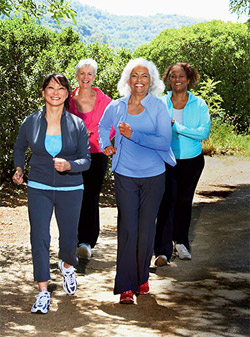
A study has established that group behavioral therapy that encouraged walking at home improves mobility among patients. Group behavioral therapy that encouraged walking at home significantly improved and prevented mobility loss among patients with clogged arteries in the legs, according to research in the Journal of the American Heart Association.
Known as peripheral artery disease (PAD), clogged arteries in the legs can cause pain and fatigue while walking. Maintaining mobility is integral to preserving functional independence, social interactions and daily activities.
Although studies have shown that supervised exercise on a treadmill improves walking endurance among people with PAD, insurance usually doesn’t pay for it and traveling to an exercise facility regularly may be difficult. Previously, the researchers found that group behavioral therapy improved six-minute walking distance, treadmill walking time and physical activity in PAD patients. But the effects of behavioral therapy on mobility remained unclear.
In this study, 194 PAD patients, 65 and older, were randomly assigned to an exercise or control group. For six months, the exercise participants attended weekly, facilitator-led group meetings that encouraged walking exercise at home at least five days a week. The control participants attended weekly lectures on health topics unrelated to exercise.
During a second six month period, those in the exercise group received phone calls from the facilitator, who encouraged them to continue walking at least five days a week.
Researchers found:
Almost 83 percent in the exercise group regained mobility (ability to climb a flight of stairs or walk ¼ mile without assistance) compared to 36.4 percent in the control group at six-month or 12-month follow-up visits. The exercise group had significant improvement in the combined outcome of four-meter walking speed, repeated chair rises and standing balance after 12 months.
Occurrence of mobility loss at any time during the study was 8.6 percent in the exercise group compared to 33.9 percent in the control group at 12 month follow-up. “These findings are particularly important because PAD patients have significantly higher rates of mobility loss compared to those without PAD,” said Mary McDermott, M.D., lead author of the study and Jeremiah Stamler Professor at Northwestern University Feinberg School of Medicine in Chicago, Illinois.
PAD is more common among older adults, and smoking, diabetes, high blood pressure and high cholesterol increase the risk. It’s easy to diagnose and can be managed with lifestyle changes and medication. “Patients should understand that home-based exercise can help prevent mobility loss, and healthcare providers should recognize that this kind of exercise can be beneficial for their patients with PAD,” McDermott said. The study has been done by American Heart Association.